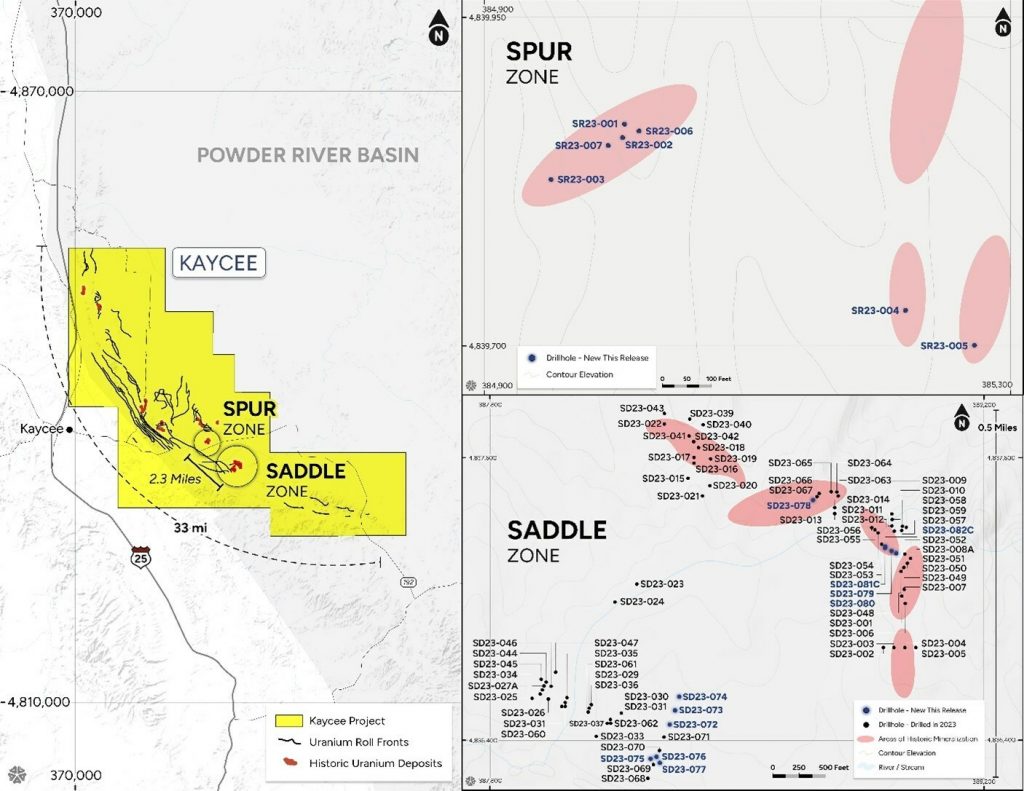
Nuclear Fuels (CSE:NF) has reported positive results from its ongoing drill program at the Kaycee Uranium Project located in Wyoming’s Powder River Basin.
The program confirmed and expanded historic uranium mineralization at both the Spur Zone and the Saddle Zone, which are located two miles apart from each other along the trend. The final results from the 2023 program include:
- Saddle Zone: Three drill holes intersected significant uranium zones.
- Spur Zone: Five holes showed positive results from the initial drilling.
Drill depths ranged from 350 to 600 feet, with ten of the eighteen holes detecting anomalous uranium mineralization.
Michael Collins, Chief Executive Officer, commented in a press release: “Drilling 2023 validated and expanded on the robust nature of Kaycee uranium mineralization. The company is well funded and building the 2024 program to test and expand on high priority targets along the over 110 miles of roll fronts identified along the 33 mile long trend we have at Kaycee. Nuclear Fuels will continue to expand and add to its project portfolio as its active research program uncovers more valuable uranium projects.”
The 2023 program included a total of 89 drill holes. Planning is underway for a larger program scheduled to begin in early Q2-2024.
Kaycee Uranium Project
The Kaycee Project is Nuclear Fuels’ priority project and covers over 42 square miles of mineral rights within the Powder River Basin. It boasts a 33-mile mineralized trend hosting over 110 miles of identified roll fronts.
The project is believed to be unique in the region, as it encompasses all three historically productive sandstone formations (Wasatch, Fort Union, and Lance) potentially suitable for In-Situ Recovery (ISR) extraction. Notably, the Kaycee Project marks the first time since the early 1980s that the entire district has been under the control of a single company, Nuclear Fuels.
Nuclear Fuels acquired the Kaycee Project from enCore Energy Corp., which holds a back-in right to acquire 51% ownership by fulfilling specific financial obligations.
Wyoming: A Leading Uranium Producer
Wyoming has a long history of uranium production and boasts a supportive regulatory environment for ISR projects. As one of the few “Agreement States,” Wyoming enjoys streamlined permitting processes compared to most other states due to the transfer of regulatory authority from the federal government to the state.
The state ranks second in the nation for historic uranium production, exceeding 250 million pounds, with the majority extracted through ISR methods since 1990, primarily within the Powder River Basin.
Highlights from the results are as follows:
- Spur Zone mineralization was intersected on trend 2 miles northwest of the Saddle Zone with hole SR23-002 returning 3.5 feet of 0.141% U3O8 from a depth of 415.5 feet and 4.5 feet of 0.223% U3O8 from a depth of 422.0 feet for a combined GT of 1.543. (Grade Thickness or GT is the thickness times the grade; GTs in excess of 0.25 are considered suitable for inclusion in a potential wellfield.)
- Holes SR23-001 and SR23-006 both returned impressive GTs of 0.912 and 0.630 respectively from similar depths.
- Permitting is ongoing to:
- Expand the area under the Drill Notice with Wyoming Department of Environmental Quality, and
- Expand the permitted number of drill holes in that program to a minimum of 600 holes in the 2024 drill season.
Table of Significant Results
|
Drill Hole ID |
From (ft) |
Thickness (ft) |
% Grade U3O8 |
GT (grade x |
Total Hole |
|
SD23_079 |
247.5 |
1.5 |
0.036 |
0.054 |
|
|
SD23_080 |
262.5 |
4.5 |
0.071 |
0.320 |
|
|
SD23_081C |
277.0 |
6.0 |
0.081 |
0.486 |
|
|
SR23_001 |
401.5 |
5.5 |
0.141 |
0.776 |
|
|
SR23_001 |
413.5 |
2.0 |
0.068 |
0.136 |
0.912 |
|
SR23_002 |
415.5 |
3.5 |
0.141 |
0.494 |
|
|
SR23_002 |
422.0 |
4.5 |
0.233 |
1.049 |
1.543 |
|
SR23_003 |
389.0 |
2.5 |
0.052 |
0.130 |
|
|
SR23_004 |
364.5 |
1.5 |
0.032 |
0.048 |
|
|
SR23_006 |
416.0 |
3.0 |
0.117 |
0.351 |
|
|
SR23_006 |
432.5 |
3.0 |
0.093 |
0.279 |
0.630 |
|
Drill holes are reported that returned significant zones of uranium mineralization with >2 ft thickness at or above a grade cut-off of 0.02 per cent eU3O8 or that are relevant to exploration targeting. (1) %U3O8 by Gamma logging is a measure of gamma intensity from a decay product of uranium. Gamma log assays may be in disequilibrium with ICP-MS assays. Comparisons of U3O8 Gamma log and ICP-MS assays of Powder River Basin core samples indicate that U3O8 Gamma is comparable to ICP-MS uranium assay in the Powder River Basin. (2) Grade Thickness, or GT, is defined as the product of the mineral grade multiplied by the thickness of the mineralization. |



 Follow us on Twitter
Follow us on Twitter Become our facebook fan
Become our facebook fan










Comments are closed.